Our Canon SWOT Analysis examines the Strengths, Weaknesses, Opportunities, and Threats of the manufacturer of electronic products like cameras, printers, etc.
What is the one brand that comes to your mind when we talk about cameras? Of course, you must be thinking about Canon since it is one of the biggest manufacturers of cameras and accessories.
We often associate Canon with cameras, but are you aware that besides manufacturing cameras, Canon is also a big manufacturer of other electronic products such as projectors, printers, scanners, etc?
At this point, it is also essential to mention that Canon also contributes significantly to the healthcare sector since it has manufactured some of the high-tech machines used in the health sector across the globe, such as MRI and CT machines.
No doubt Canon is usually known as a camera manufacturing brand, but over the years, it has diversified its operations and manufactured products of different natures. After looking at the nature of Canon, today we have decided to conduct a Canon SWOT Analysis.

A SWOT analysis is a strategic planning tool that helps businesses identify their strengths, weaknesses, opportunities, and threats. It is typically used to assess a company's internal and external environment. It can be applied to a product, place, industry, or person.
A SWOT template can be useful for businesses of all sizes and industries, as it helps them understand their current position and how to move forward most effectively.
Now that we have discussed what SWOT analysis is in quite a detail, let's look at Canon's history and current operations to know about the brand.
Canon is a Japanese multinational corporation headquartered in Tokyo, Japan. Its roots can be traced back to 1937, when the Precision Optical Instruments Laboratory was founded to research cameras.
As a result, a year later, Canon developed its first 35mm focal plane shutter camera prototype in 1937. In the coming years, Canon kept focusing on cameras and launching better quality cameras.
In the early 1960s, Canon entered the business machine market and soon started producing paper copier machines, calculators, and other machines. Besides that, it also began to manufacture X-ray mirror cameras.
In the 1970s, Canon launched the F-1, a high-end SLR camera, and the L series of lenses, which have become industry standards. In the 1980s, Canon introduced the first inkjet printer, the BJ-80, and the first color laser printer, the CLC-1.
In the 1990s, the company expanded its business to include office equipment, medical equipment, and industrial products. Today, Canon is a leading manufacturer of a wide range of products, including cameras, printers, copiers, and other office equipment. It is also a major player in the market for consumer and professional imaging equipment.
Since Canon manufactures many good quality products that cater to the needs of people from different industries, it has a large customer base. People from all over the globe demand Canon products. Currently, Canon operates in more than 220 countries and regions.
Such a large customer base helps Canon to generate significant revenue. As a result, the brand generated $30.867 Billion in 2022. Such huge revenue shows that the company is in a good financial position.
Moreover, Canon also contributes to the global workforce significantly. In 2021, it employed 184,034 employees. Now that you are fully aware of Canon let's proceed and conduct a Canon SWOT analysis.

Strengths of Canon
The strengths section in the SWOT analysis highlights the characteristics of a business that give it an advantage over others. These can be internal or external factors. Let's see what strengths Canon has.
Strong Brand Recognition And Reputation
Canon is widely recognized and respected within the imaging and printing industry. This is a strength because strong brand recognition can help a company to stand out in a crowded market, attract new customers, and retain existing ones.
Since Canon has been producing cameras and office machines for almost nine decades, people associate Canon's products with high quality. This can make it easier for Canon to attract new customers, as they may be more likely to consider the company's products when making a purchase decision.
Strong Global Presence
Canon is a multinational company that operates in many countries around the world. It has established subsidiaries, affiliates, and research and development centers in different regions to help it better serve its customers and expand its business.
These subsidiaries, affiliates, and centers are responsible for a variety of tasks, including sales and marketing, product development, and technical support. By having a strong global presence, Canon is able to reach a wide range of customers and stay at the forefront of technological innovation.
Diverse Product Range
Canon is a diversified technology company that offers a wide range of products and services. Its product portfolio includes a variety of cameras, including digital cameras, film cameras, and professional-grade cameras for photography and videography.
Canon also offers a range of printers, including inkjet, laser, and multifunction printers for printing, scanning, copying, and faxing. In addition, Canon offers a range of office equipment, such as copiers, scanners, projectors, and medical and industrial equipment.
A diverse product range allows Canon to generate revenue from multiple sources, rather than relying on a single product or service. This can help mitigate the impact of fluctuations in demand for any one product and provide a more stable and predictable revenue stream for the company.

Weaknesses of Canon
In a SWOT analysis, the weaknesses section is used to identify the internal factors hindering a company's ability to achieve its goals or contributing to its challenges. So now, let's discuss what weaknesses Canon possesses.
Reliance On External Suppliers
Like many companies, Canon relies on a network of external suppliers to provide the raw materials, components, and other resources it needs to manufacture its products. For example, Canon relies on HP Web Jetadmin and HP Open Extensibility Platform.
While external suppliers can help a company access a wider range of resources and be more cost-effective than producing everything in-house, they can also create certain vulnerabilities.
Suppose a supplier experiences difficulties, such as a production issue or a natural disaster. In that case, it can disrupt the supply of materials to Canon and potentially impact the company's ability to manufacture its products. This can lead to delays, increased costs, and reduced profits.
Controversy
Canon is a well-respected and successful company known for its high-quality products and strong performance. However, like any company, it has faced challenges and controversies from time to time.
For example, the defects in the Rebel T6s and T6i DSLR cameras were acknowledged by Canon in 2015, and the company had to recall its products from the market. In addition, this incident affected Canon's reputation and financial performance since the company incurred additional costs related to the recall, such as repairing or replacing defective products.
Less Recognition of Products Other Than Cameras
Canon is a diversified technology company that offers a wide range of products, including cameras, printers, copiers, scanners, and projectors. While Canon is known for its high-quality imaging products, such as cameras, its other products may not be as well known to the general public.
Cameras are a popular consumer product that many people are interested in, and Canon has a strong reputation in this market. In contrast, projectors are a less well-known product that may not be as top-of-mind for most people. As a result, Canon may have less recognition and awareness for its office machine products compared to its camera products.
Opportunities Present For Canon
The opportunity section is used to identify potential opportunities that an organization or individual can take advantage of. These opportunities can be external or internal to the organization. For example, they may relate to new markets, technologies, competitive landscape changes, or other trends that can be leveraged to the organization's advantage.
Although Canon is a well-established brand, some opportunities exist for Canon to grow further.
Increasing Demand For Electronic Market
The universal consumer electronics industry refers to producing and selling electronic devices and appliances used in households and everyday life, such as smartphones, laptops, TVs, appliances, and other home electronics.
This industry is growing as demand for consumer electronics increases, particularly in developing markets where household incomes are rising. As a company in this industry, Canon could potentially capitalize on this trend by developing new products and technologies that meet the needs and preferences of consumers in these markets.
For example, Canon could invest in research and development to create innovative and high-quality electronics tailored to consumers' specific needs and preferences in these markets. This could include introducing new features, designs, or technologies that are relevant and appealing to these consumers.
Mergers And Acquisitions
When a company like Canon enters into a partnership or collaboration with another company or organization, it essentially forms an agreement to work together on a particular project or venture.
This can be a mutually beneficial arrangement, as the partnering company can gain access to resources and expertise that it may not have internally, while Canon can expand its reach and potentially tap into new markets or customer bases.
Partnerships and collaborations can take many forms, including joint ventures, licensing agreements, or strategic alliances. By exploring these types of partnerships, Canon can potentially gain a competitive advantage and drive growth for its business.
Growth In The Medical Device Industry
The worldwide medical device industry is experiencing ongoing expansion, which aligns with the company's plan to grow in this sector. This growth will allow the company to broaden its range of products and increase its market share.
Growth in the medical device industry in the coming years will cause the demand for medical devices to increase. As a result, more business will be generated for Canon.

Threats Faced By Canon
The threats section identifies external factors that could negatively impact the organization. These might include competition, changes in market conditions, regulatory changes, technological advances, and economic downturns. Let's have a look at the threats faced by Canon.
Change In Consumer Preferences
The camera industry has been experiencing a decline in recent years due to the increasing popularity and capabilities of camera phones. As a result, sales of standalone cameras, including those produced by Canon's camera division, have been impacted.
The rise of camera phones has made it more convenient for people to capture photos and videos, as they always have their phones and do not need to carry an additional device. However, this approach will cause the demand for cameras to fall further in the future, negatively affecting the sales of Canon's camera division.
Political Unrest In Countries
Political unrest between countries can create a range of challenges for businesses, including Canon. For example, suppose there is political unrest in a country where Canon operates or sells products. In that case, it could disrupt the company's supply chain, making it difficult to obtain raw materials or manufacture and distribute products.
In addition, political unrest can lead to economic instability and a decline in consumer spending, which could negatively impact Canon's sales. Political unrest can also create regulatory hurdles or legal challenges for the company.
For example, suppose trade sanctions or restrictions are put in place due to political tensions between countries. In that case, Canon may face difficulties exporting or importing goods. Overall, political unrest can create uncertainty and risk for Canon and negatively impact its sales and operations.
High Competition
Canon operates in a highly competitive market where several well-established brands pose a threat to the company. Canon's main competitors include Nikon, Sony, and other manufacturers producing cameras and imaging products.
These companies can be a threat to Canon in several ways. For example, they may offer products perceived as being of higher quality or offer more features at a lower price, which could lead consumers to choose their products over Canon's.
Additionally, these competitors may have stronger distribution networks or more effective marketing and advertising strategies, which could give them an advantage over Canon.
To address these threats, Canon must continuously innovate and differentiate its products and develop strong marketing and sales strategies to stay competitive.

Canon SWOT Analysis: Final Word
Canon is a well-established brand famous for high-quality manufacturing cameras and other office and healthcare machinery. The brand has been operating in the market for almost a century. Yet, it has managed to keep itself relevant.
All these characteristics of Canon make it different from other brands, so today, we decided to conduct a Canon SWOT analysis. In this SWOT analysis, we discussed some of the strengths and weaknesses of the brand.
Moreover, we also shed light on the opportunities and threats faced by the company from the external environment. After reading this article, we assume you know how to conduct a SWOT analysis.
At this point, you might be wondering if there is any other way to represent the findings of a SWOT analysis. Another way to represent the results of a SWOT analysis is through a SWOT Matrix or a SWOT table. This is a more efficient way to represent the results of a SWOT analysis.
SWOT analysis is a very useful and helpful technique. To learn more about it, look at some of its examples and check out some SWOT analysis alternatives.


